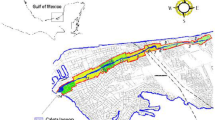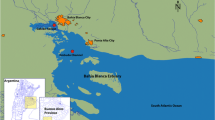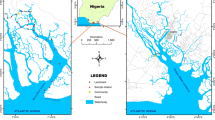Abstract
This study reports the levels and distribution patterns of selected polycyclic aromatic hydrocarbons (PAHs) in fish samples of the Gomti river, India, collected from three sites during the pre- and post-monsoon seasons of the years 2004–2005. In the fish muscles, ∑PAHs ranged between 12.85 and 34.89 ng g−1 wet wt (mean value: 23.98 ± 6.70 ng g−1). Naphthalene was the most prevalent compound both in terms of detection as well as levels, while, benzo[k]fluoranthene, benzo(a)pyrene, and indeno(123-cd)pyrene + benzo(ghi)perylene could not be detected in any of the sample. Low-molecular weight PAHs were observed dominating over the high molecular weight PAHs.



Similar content being viewed by others
References
Bouloubassi J, Saliot A (1991) Composition and sources of dissolved and particulate PAH in surface waters from the Rhone delta (NW Mediterranean). Mar Pollut Bull 22:588–594
Bouloubassi J, Saliot A (1993) Investigation of anthropogenic and natural organic inputs in estuarine sediments using hydrocarbon markers (NAH, LAB, PAH). Oceanol Acta 16:145–161
Deb SC, Araki T, Fukushima T (2000) Polycyclic aromatic hydrocarbons in fish organs. Mar Pollut Bull 40:882–885
DouAbul AAZ, Heba HMA, Fareed KH (1997) Polynuclear aromatic hydrocarbons (PAHs) in fish from the Red Sea coast of Yemen. Hydrobiologia 352:251–262
Kong KY, Cheung KC, Wong CKC, Wong MH (2005) The residual dynamic of polycyclic aromatic hydrocarbons and organochlorine pesticides in fishponds of the Pearl river delta, South China. Water Res 39:1831–1843
Laflamme RE, Hites RA (1978) The global distribution of PAH in recent sediments. Geochim Cosmochim Acta 42:289–303
Lake JL, Norwood C, Dimock C, Bowen R (1979) Origins of polycyclic aromatic hydrocarbons in estuarine sediments. Geochim Cosmochim Acta 43:1847–1854
Latimer JS, Zheng J (2003) Sources, transport, and fate of PAHs in the marine environment. In: Douben PET (ed) PAHs: an ecotoxicological perspective. Wiley, UK
Lee ML, Prado GP, Howard JB, Hates RA (1977) Source identification of urban airborne polycyclic aromatic hydrocarbons by gas chromatography-mass spectrometry and high resolution mass spectrometry. Biomed Mass Spectrom 4:182–186
Liang Y, Tse MF, Young L, Wong MH (2007) Distribution patterns of polycyclic aromatic hydrocarbons (PAHs) in the sediments and fish at Mai Po marshes nature reserve, Hong Kong. Water Res 41:1303–1311
Malik A, Singh KP, Mohan D, Patel DK (2004) Distribution of polycyclic aromatic hydrocarbons in Gomti river system, India. Bull Environ Contam Toxicol 72:1211–1218
Neff JM (1985) Polycyclic aromatic hydrocarbons. In: Rand GM, Petrocilli SR (eds) Fundamentals of aquatic toxicology. Hemisphere, New York
Payne JF, Mathieu A, Collier TK (2003) Ecotoxicological studies focusing on marine and freshwater fish. In: Douben PET (ed) PAHs: an ecotoxicological perspective. Wiley, UK
Schmeltz I, Tosk J, Hilfrich J, Hirota N, Hoffman D, Wynder EL (1978) Bioassay of naphthalene and alkylnephthalene for carcinogenic activity: relation to tobacco carcinogenesis. In: Jones PW, Freundenthal RI (eds) Carcinogenesis, polynuclear aromatic hydrocarbons, vol 3. Raven Press, New York
Tolosa J, Bayona JM, Albaigés J (1996) Aliphatic and polycyclic aromatic hydrocarbons and sulfur/oxygen derivatives in northwestern Mediterranean sediments: spatial and temporal variability, fluxes, and budgets. Environ Sci Technol 30:2495–2503
UNEP (2003) Global report on regionally based assessment of persistent toxic substances. UNEP Chemicals, Geneva
USEPA (1996a) Method 3540C: soxhlet extraction. US Environmental Protection Agency, Washington
USEPA (1996b) Method 3660B: sulfur cleanup. US Environmental Protection Agency, Washington
USEPA (1996c) Method 3620B: florisil cleanup. US Environmental Protection Agency, Washington
Varanasi U, Stein JE (1991) Disposition of xenobiotic chemicals and metabolites in marine organisms. Environ Health Perspect 90:93–100
Varanasi U, Stein JE, Nishimoto M (1989) Biotransformation and disposition of polycyclic aromatic hydrocarbons (PAH) in fish. In: Varanasi U (ed) Metabolism of polycyclic aromatic hydrocarbons in the aquatic environment. CRC Press, Boca Raton
Acknowledgment
The authors are thankful to the Director, Industrial Toxicology Research Centre, Lucknow, for his consistent support and interest in this work.
Author information
Authors and Affiliations
Corresponding author
Rights and permissions
About this article
Cite this article
Malik, A., Ojha, P. & Singh, K.P. Distribution of Polycyclic Aromatic Hydrocarbons in Edible Fish from Gomti River, India. Bull Environ Contam Toxicol 80, 134–138 (2008). https://doi.org/10.1007/s00128-007-9331-3
Received:
Accepted:
Published:
Issue Date:
DOI: https://doi.org/10.1007/s00128-007-9331-3




